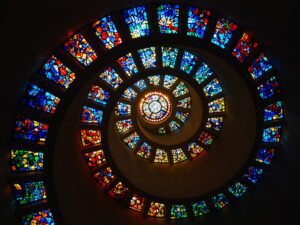Ancient Old World
This section explains the various ways the Beatific Vision was shown, depicted and described throughout the thirty-three or more centuries of the traditional Ancient Old World.
As I’m sitting here contemplating what to get into with the Ancient World, I’m realizing how much more difficult it is than I thought it would be. There’s so much from the past visible, so much hidden, so much lost, so much purposely destroyed as in the Ancient New World or purposely hidden. So many points of view regarding this or that. So again, I will try not to stick my nose into historical and scholarly things since as I said on my podcast I’m not an expert in either of these and instead, I will try to stay focused on the task at hand which is showing the symbol and image of the mystical experience; again, what I as a Catholic call the Beatific Vision of God but has been called many things by many people, though all have shown it in exactly the same manner.
I’ll start with where I saw it first when I sat and meditated digging into my memory once the first recognitions of the symbol and pattern for the experience began to penetrate my mind. It wasn’t hard. I had only to think of the classics or if I say it in capital letters, The Classic. I mentioned in my Season One Podcast the love I’ve always had for myth, classical myth in particular due to having spent five years during my formative youth in Santa Monica, California, and the frequent trips to the classic Getty Museum.
What’s interesting is as a child I read the Odyssey front to back. I don’t remember the experience that well and was probably just trying to find the monsters and the killing and stuff, but I remember forcing myself to read it in the third grade regardless of whether I knew the words or not. Here and there I’d grab a dictionary and try to look up the words I didn’t understand but since that would make the reading boring since there were lots of words I didn’t understand, there was a give-n-take of dictionary referencing much like now as an adult there are times I dig deep into the footnotes while reading works that have footnotes, or other times I wish the footnotes were all crammed in the back since they’re sometimes a distraction if right on the page I’m reading.
What’s interesting is I’d never read the Iliad as a child, just the Odyssey. And even as an adult, I primarily spent time with the Odyssey. But I finally got a new copy of the Iliad and read it again almost seemingly for the first time with that weird, did the book change or does it appear different because now I am different effect from reading a work more than once. And if I remember correctly, I think I read it again immediately once completed.
Just to quickly give the images in the Odyssey before moving forward, they are the whirlpool of Charybdis and possibly even the sea monster Scylla. I haven’t thought about it in a while since my mind has been focused on the image in the Iliad—for a reason I’ll explain later—so I will have to get back to this at some point.
So rather than try to explain it, I’ll just read it for you. The main point of this exercise is to understand that many of these ancient works are not just stories, or that many of the myths are not just myths. Yes, a whole heaping pile of the myths are just myths and fun or humorous stories and nothing else which unfortunately degraded their conception of the Divine much like as I’ve been clear to spell out repeatedly from any and all of the superstitions that arise in any religious, spiritual and now science-fiction imaginings. So, as I’ve said, it can be extremely difficult to follow the Baptist’s direction of separating the wheat from the chaff. The stories are there to help draw one’s mind in and slowly unveil the mysteries embedded inside, but they are mystical, very mystical.
If you’ve seen any of the other images on this website or are familiar with the Iliad, it should be obvious considering Homer probably spends more time describing this single object than anything else in the poem. Since this is where the symbol, image and pattern exists, Homer was careful to give it exquisite detail.
I will read from the Robert Fagles translation of the Iliad, Chapter 18 (558-709), the Shield of Achilles. It takes a few pages, and I did provide an artist’s image from the 18th century of it in the gallery if you need a further visual. To set the scene, Achilles’s mother the goddess Thetis has gone up to Mount Olympus to ask the Smith of the gods, Hephaestus in the Greek, to forge armor for her son for the upcoming battle. He agrees and this is what he hammers out. . .
Complete Works of Julian, 2019, Delphi Classics, Hastings, United Kingdom.
Excerpt(s) from THE ILIAD by Homer, translated by Robert Fagles, translation copyright © 1990 by Robert Fagles. Used by permission of Viking Books, an imprint of Penguin Publishing Group, a division of Penguin Random House LLC. All rights reserved.
THE ILIAD by Homer, translated by Robert Fagles. © 1990 by Robert Fagles. (Viking Penguin, 1990) Reprinted by permission of Georges Borchardt, Inc., for the Estate of Robert Fagles.


